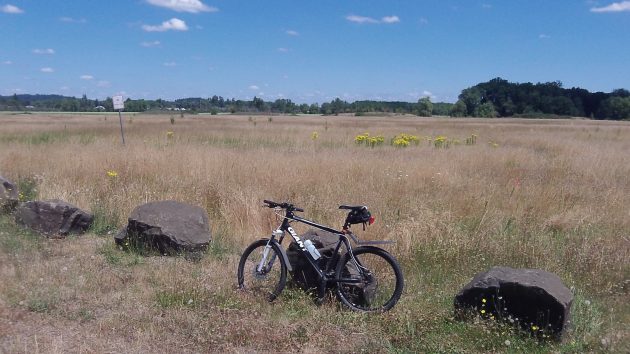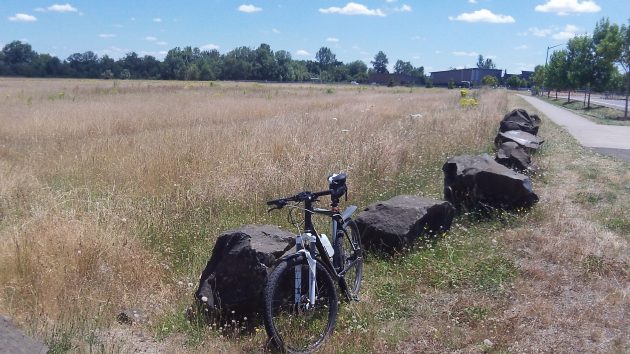
Tax lot 100 at NE Somerset and Timber Ridge: Only the inside of the bike’s water bottle is wet.
Wetlands again? Yes, once again the designation of normally dry ground as wetlands is likely to cost the city of Albany some money.
In late 2010, the Albany council agreed to spend nearly $3.5 million from its Pepsi settlement fund to finance the construction of Timber Ridge Street.for the new Timber Ridge School. The costs were assessed against adjoining parcels including the school site and private land known as the Brandis property. The council invested the Pepsi money this way because assessments by law carried an interest rate of 6.5 percent, while city deposits in the state investment pool earned far less.
When payments on the private parcels fell behind a few years later, the city took ownership of two of the undeveloped parcels — totaling about 52 and 23 acres respectively — in lieu of foreclosure. The idea was that the city would sell the land and recoup its investment in the street project. To that end, the council last December agreed to pay for an evaluation of the property under wetlands rules.
The result: Almost all the land north of Timber Ridge School, about 36 acres in tax lot 100, is now a designated wetland. And so is part of tax lot 101 west of Timber Ridge Street.
The city says it has received “a handful of inquiries” from parties interested in buying some of the land. But Kate Porsche of the city staff told the council last Monday that the potential purchase prices were below the earnings the city had hoped for when it invested in the street. If that’s the outcome eventually, one likely reason is the discovery of such extensive wetlands.
On both tax lots 100 and 101 together, the assessments plus accumulated interest so far amount to nearly $4.2 million. That’s the amount that Finance Director Stewart Taylor lists as a “receivable” of the Pepsi settlement fund if and when the property is sold. No one knows if the city will get that amount. If not, one of the likely reasons will be the designation of normally dry land as wetlands that, under state and federal rules, must be preserved or recreated somewhere else. (hh)

Look at all that supposed wetland, with Timber Ridge School in the distance.

Nothing like fantasizing on what might or might not happen in the future.
Comes under the heading of a slow news day, except for the three cops gunned down in Baton Rouge.
Must be a slow day in your world Bob Woods that you have to make rude smart a** remarks!
Who doesn’t like a good fantasy?
It was cloudy yesterday in stark contrast the two images which leads me to wonder if this blog entry was on the shelf. Along with a few others. That is great. I enjoy checking in to see new subjects (and some old ones) to read and think about. Keep doing what you are doing HH.
Agreed! Terrible news in BR. Just on the heels of Big D. Bullets be a flying in this country awash in guns. Hope this problem doesn’t appear in Cleveland as the feces show gets under way. Stay safe.
And another irrelevant personal attack by hj.anon who is still doesn’t know the meaning of ” ad hominem attack”. Which thus renders his comments meaningless.
It really helps to remind us that the inmates are running the asylum, even on another bad news day. The state government claims ownership of all its water and the federal government regulates it. No wonder they find more and more in more places. What happened to our private property rights? They represented the corner stone of our freedom when we still had it.
It’s high time to get rid of the EPA. It doesn’t exercise a enumerated power of the US Constitution and so is unconstitutional anyway (see Amendment 10).
It still confuses me how you can take “Wetlands”, move them to dry land and make them “Wetland” but you can not move dry land to wetland and make it dry? As Desi Arnez used to say, “Splain that to me Lucy.”
Simple. A compromise was made. I get you. It doesn’t make any sense. Brings up a discussion …if you want.
To all: In this time of clear division, how do we move forward without compromise? Surely, WAR and the complete submission of one side is not the answer. That leaves compromise.
Thoughts? Beeson? Anyone?
I expect the EPA compromise was to do a science based study of how to tell if soil is to be classified as wetlands based on I believe the presence of four characterists. Then they did formed tests and tried to figure out simple ways to say yes or no on a characteristic. If you get a positive on four characteristic via field teats then the presumption is “wetlands” but the landowner can rebutt. On the other hand the EPA does not need field
Tests to say “wetlands” but the presumption is NOTwetlands.
I only read the part about hydrite soils. This seems to be a field test that is a proxy for soil does not have any oxygen in it part of the time now or in the past.
So this looks good to me. On the other hand there are problems
around that somehow get into principled battles on maybe both sides that need to be figured out. For instance, suppose a farmer is worried that the river will change course and his land will disappear.